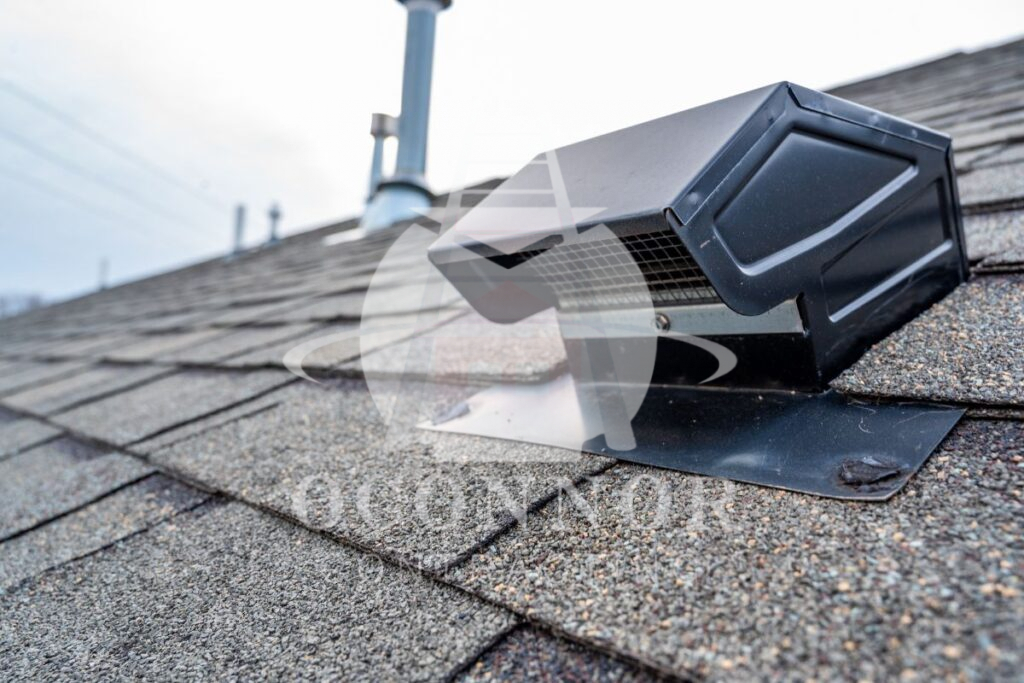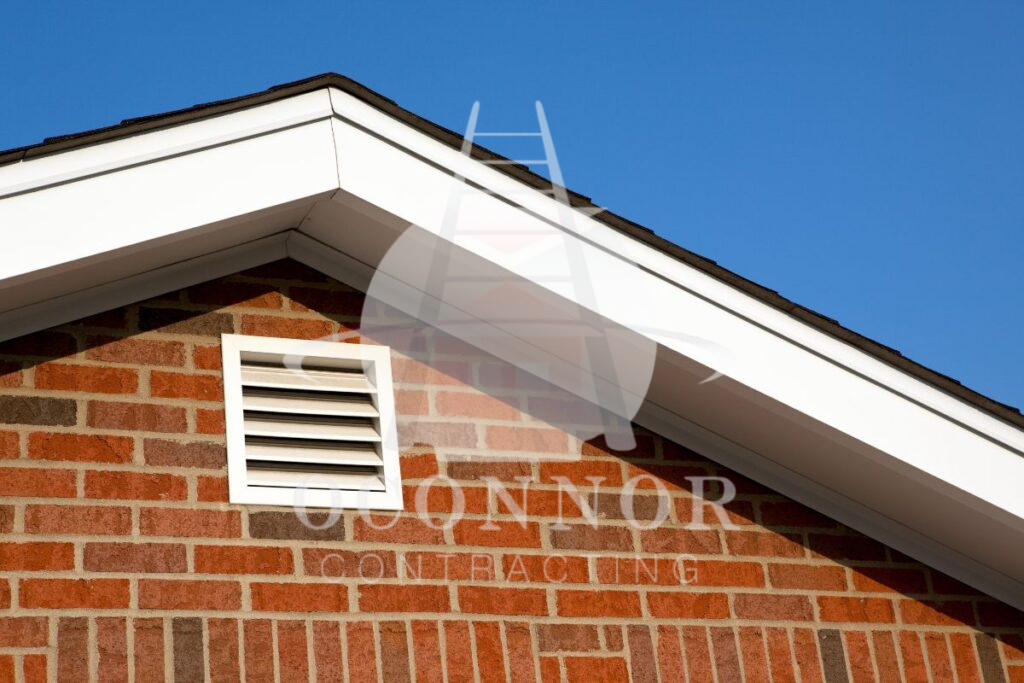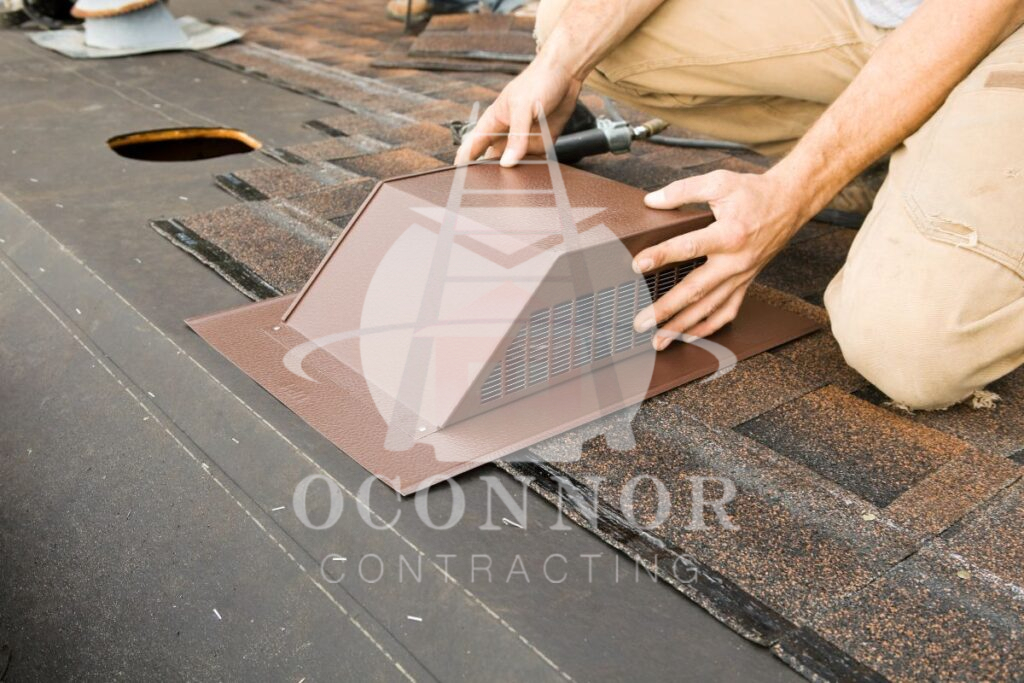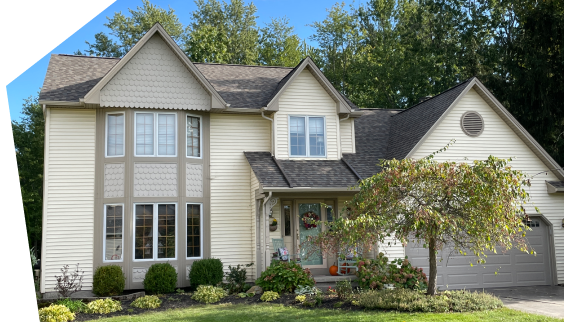Ever wondered how to keep your home healthy and save on energy costs? It’s all about ventilation. Roof vents are crucial because they remove hot air and moisture from your attic, therefore preventing roof damage and reducing your energy bills.
But with so many to choose from, it can be hard to pick the right one. To help you out, this blog post will explain the pros and cons of different roof vents, so you can make a smart choice for your home.
What Are The Two Main Types Of Roof Vents For Houses?
1. Exhaust Vents

Exhaust vents are installed at higher points on the roof, such as ridges or hip lines, to expel stale, humid air from the attic. Their key roles include:
- Removing moisture and odors from the attic
- Preventing ice dams on the roof
- Mitigating mold growth and wood swelling
- Maintaining consistent attic temperature
2. Intake Vents
Intake vents, typically placed lower on the roof like soffits, bring fresh, outside air into the attic. Their primary functions are to:
- Supplying fresh air to the attic
- Preventing moisture accumulation in joist bays
- Ensuring proper airflow with ventilation in the attic
- Maintaining consistent attic temperature
Also Read: Roof Vents 101: Types, Cost & Best Products In The Market
What Are The Best Types of Roof Vents For Buffalo Homeowners?
#1. Ridge Vents

Ridge vents are an essential part of any roof ventilation system located along the peak of the roof to expel hot, moist attic air and intake fresh air via soffit vents, crucial in hot climates to reduce energy consumption and prevent roof damage.
They maintain a continuous airflow along the roof’s peak as rising hot air exits through the ridge vent, while cooler air enters through soffit vents, cooling the attic and reducing the amount of heat transfer to interior living spaces.
Proper installation by a professional roofer ensures effective function. This is because the system is complex and involves utilizing insulation beneath the ridge vent to prevent unwanted heat influx, making it ideal for climates like Buffalo’s varied weather conditions.
| PROS | CONS |
| Efficiency: Run along the roof’s peak for consistent ventilation. Aesthetics: Blend seamlessly with the roofline. Weather Protection: Include external baffles for airflow and weather resistance. Pest Control: Narrow design deters pests from entering the attic. | Installation Challenges: Require precise installation for effectiveness. Dependence on Soffit Vents: Effectiveness relies on adequate soffit ventilation. Insufficient Ventilation in Hot Climates: There may not be enough ventilation for very hot areas. Cost Considerations: Installation costs can be higher, averaging $300 to $650. |
#2. Soffit Vents (Eave Vents)

Another great option for ventilation is soffit vents, also called eave vents, which are vents installed on the underside of a roof’s overhang. They allow outside air into the attic, removing heat and moisture that would otherwise harm the roof and its structural components.
They are usually installed along the soffit, the horizontal surface beneath the eaves, to ensure consistent airflow throughout the attic, promote ventilation, and maintain a balanced environment.
| PROS | CONS |
| Effective Ventilation: Provide continuous airflow to remove heat and moisture. Easy Installation: Attach directly to the soffit for a straightforward setup. Cost-Effective: Less expensive to install and maintain than other ventilation systems. Aesthetically Pleasing: Designed to blend discreetly with the roof’s structure. | Limited Airflow: May not effectively ventilate larger attics or those with thick insulation. Dependence on Wind: Efficiency can vary with wind direction and speed. Potential for Debris: Prone to clogging with leaves and twigs, reducing effectiveness. Not Suitable for All Roof Types: Less effective for very steep or complex roof designs. |
#3. Gable Vents (Louver Vents)

Gable vents, installed on the gable end of a home, are passive ventilation systems that allow for airflow through the attic without mechanical fans. Paired with soffit vents beneath roof overhangs, they balance airflow by allowing cool air in and warm air out.
This setup regulates attic temperature and humidity, mitigating moisture damage and mold growth. Gable vents come in various materials and styles to match the home architecture, offering both aesthetic appeal and functional ventilation benefits.
| PROS | CONS |
| Improved Ventilation: Allows hot air to escape, preventing damage. Lower Energy Costs: Facilitates airflow, reducing HVAC workload. Moisture Prevention: Helps reduce mold and mildew in the attic. | Water Intrusion Risk: Poor installation can cause attic water damage. Insulation Impact: Openings may reduce attic insulation efficiency. Pest Entry: Inadequate screening invites pests like birds and insects. |
#4. Box Vents (Louver Vents)

The next option, box vents, are a type of static ventilation system installed on top of the roof to expel stale air and moisture from a building, ensuring a healthy indoor environment.
These rectangular boxes feature small openings that allow fresh air to enter while allowing for stale air and moisture to escape. This continuous airflow prevents mold, condensation, and poor air quality by removing pollutants and excess heat, promoting a comfortable and pleasant living or working space.
| PROS | CONS |
| Effective Air Exchange: Reliable ventilation for maintaining indoor air quality. Easy Installation: Simple to install in new and existing buildings. Cost-Effective: Lower installation and maintenance costs. Low Maintenance: Requires minimal upkeep due to no moving parts, and reduced risk of clogging. | Limited Airflow: This may not suffice for larger or more complex buildings. Noise: Constant airflow may create noticeable noise. Aesthetics: Can be visually unappealing, especially since they stick out of the roof’s surface. |
Also Read: Ridge Vent vs Box Vent: What You Need To Know
#5. Roof Turbines (Whirlybird Ventilation)

Roof turbines, or whirlybird vents, are wind-powered exhaust vents that remove attic heat and moisture. These vents use wind power to spin the turbine, creating suction that pulls hot air from the attic.
This natural ventilation system does not require electricity, reducing the possibility of wood rot, mold, and mildew. During calm conditions, the turbine operates similarly to a basic box vent, relying on convection to keep air flowing through the vent.
| PROS | CONS |
| Energy Efficiency: Operates without electricity, using wind power for attic ventilation. Effective Ventilation: Helps reduce attic heat and moisture, preserving roof integrity. Affordable: Cost-effective to install and maintain. | Rust Potential: Prone to rust in humid or salty environments. Noise: Can be noisy during windy conditions. Leakage: Incorrect installation can lead to water leaks. Seasonal Performance: Less effective in low-wind conditions. |
#6. Power Vents
Another great choice for Buffalo homeowners is power vents, which are a type of ventilation system used to improve indoor air quality by efficiently removing stale air and pollutants from a building.
They usually consist of a central fan unit connected to a range or a network of ducts that distribute air throughout the building. This configuration allows for a more efficient and controlled exchange of air, lowering the risk of mold growth, odors, and other indoor air quality issues.
| PROS | CONS |
| Efficient Air Exchange: Controls air exchange effectively, improving indoor air quality. Reduced Odors and Mold: Helps eliminate odors and the risk of mold by removing pollutants. Improved Ventilation: Provides consistent ventilation compared to natural methods. Customizable: Can be tailored to specific ventilation needs and integrated with HVAC systems. | Higher Upfront Cost: Initial investment is higher than traditional methods. Noise: The central fan unit may generate noise. Maintenance Needs: Requires regular upkeep for optimal performance. Space Requirements: Requires significant space for units and ductwork, challenging in smaller buildings. |
#7. Fascia Vents
Fascia vents are positioned along the fascia board, which is the part of the roof that extends beyond the exterior walls. They are crucial for ensuring proper airflow and ventilation in the attic, regulating temperatures, and preventing moisture buildup.
These vents facilitate natural air circulation, pulling fresh outdoor air into the attic while expelling warm, moist air. This balanced airflow helps maintain optimal temperature and humidity levels, reducing the potential for mold, mildew, and other moisture-related issues.
| PROS | CONS |
| Alternative to Soffit Vents: Ideal for roofs with limited eave space, offering low-level ventilation. Easy Installation: Straightforward to install. Seamless Finish: Installed neatly under shingles for a smooth roof appearance. Prolonged Roof Lifespan: Prevents premature deterioration from heat and moisture. | Limited Surface Area: A smaller surface area may limit airflow compared to soffit vents. Installation Complications: Challenging on roofs with complex designs like multiple valleys or peaks. Maintenance Requirements: Requires regular cleaning to maintain airflow and prevent debris buildup. |
#8. Solar-Powered Vents
The last option on our list is solar-powered vents, which use solar energy to operate fans that circulate air within buildings. Photovoltaic panels convert sunlight into electrical power. This eco-friendly technology is ideal for locations lacking traditional power sources or prioritizing energy efficiency. These vents are versatile and suitable for installation on rooftops, walls, or windows, accommodating diverse architectural designs while promoting sustainable ventilation solutions.
| PROS | CONS |
| Energy Efficiency: Uses solar energy, reducing reliance on non-renewable sources. Low Maintenance: Fewer parts mean less upkeep than traditional systems. Cost-Effective: Long-term savings despite higher initial costs. | Sunlight Dependence: Performance varies with sunlight, affecting nighttime use. Higher Initial Cost: Installation is pricier than traditional vents. Noise: Operational fans can be noisy in quiet settings. Limited Capacity: May not meet high demands or suit large buildings. |
Get Effective Roof Vent Installation For Your Home
Deciding on the right type of roof vent for your home or building may seem overwhelming. However, by weighing the pros and cons of each option, you can confidently select the one that best fits your requirements. Whether you go for a power vent, solar vent, turbine vent, whirlybird vent, or ridge vent, there’s a roof vent type suited to maintaining a healthy and energy-efficient living space.
Get in touch with OConnor Contracting for quality roofing solutions. Our team specializes in both residential as well as commercial projects, delivering reliable repairs, replacements, and new installations with the best materials and craftsmanship. Call us today at (716) 600-7663.


